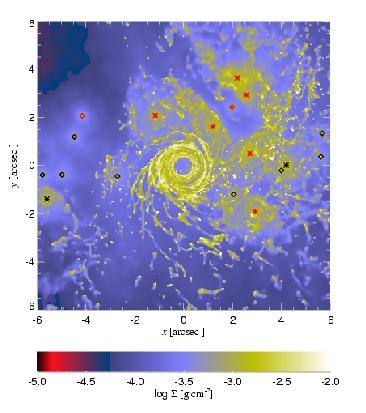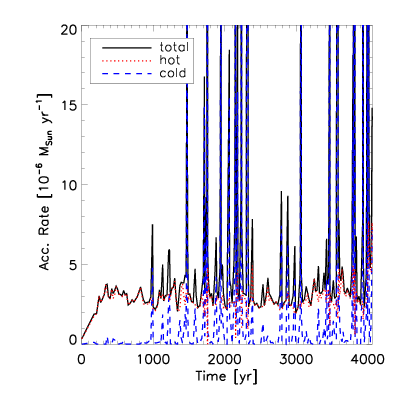
|
|
Fig. 1: Movie showing the gas expelled from the stars, the
"stellar winds", in a simulation of the Galactic Centre. The stars are
shown as black dots in the movie, and the black hole (not shown) is in
the centre. Part of the gas cools and form clumps (shown in yellow)
and, in this simulation, a disc is formed by these clumps. However,
most of the gas escapes from the inner region, while a small quantity
is consumed by the black hole. [To play you may need to install the
free DivX codecs.]
|
 |
 |
|
Fig. 2:"Accretion rate", that is the quantity of gas consumed by
the black hole, as a function of time for the simulation shown in
Fig. 1. When one of the cool clumps goes to the proximity of the black
hole, it is eaten and a peak in the accretion rate is produced.
|
|  |
It is now believed that there is a
super-massive black hole at the centre of every galaxy. Our own
Galaxy, the Milky Way, is no exception. At its centre, 26,000 light
years away from us, there is a very massive black hole called Sgr
A*. It is 3 million times more massive than the Sun. Astronomers
cannot see the black hole directly, but they have used the largest
telescopes to measure the motion
of stars close to it. The orbits of stars around Sgr A*, like the
Moon orbit around the Earth, permit astronomers to calculate the mass
of the central object, and in this case show beyond any doubt the
presence of the giant monster.
Even though black holes cannot be
directly seen (they are black), the gas that falls onto them
usually emits a lot of radiation, because the matter is compressed by
the strong gravitational force, making it very hot. This is how
quasars are created, very bright objects in the centres of far away
galaxies, which are powered by accreting black holes. But in Sgr A*
almost nothing is seen. This is a puzzle, because there are many stars
close to the black hole. The stars are at a safe distance from the
black hole, but the gas they expel, the "stellar winds",
should be falling onto the black hole and producing much more
light. To understand the reason of this low luminosity, it is very
important to know how much gas gets captured by the black
hole. Moreover, Sgr A* is the closest massive black hole from us, and
studying its dimness will help to understand black holes in general.
In the Galactic centre, there are dozens
of stars, each producing gas that flows in all directions. The gas is
attracted to the black hole by gravity, and moreover gas streams
coming from different stars collide with each other. All this produces
very complicated gas motions. One cannot study this complexity with
analytical equations, so it is necessary to run sophisticated
simulations in super-computers to get a clear picture of what is
happening.
Using Gadget, a
computational code developed at MPA, scientists at this institute have
started to study this problem. They have found that the stellar winds
indeed produce a complicated gas morphology in the inner region (see
Fig. 1). Part of the gas forms cool clumps, and some of these clumps
have a trajectory that takes them to the black hole. Each time this
happens, maybe every 100 years, the amount of material that falls
onto the black hole, the so-called "accretion rate" (see Fig. 2),
increases, and the region could become very luminous. It is
interesting to note that observations
show that just 350 year ago Sgr A* was indeed much brighter. This
higher luminosity was perhaps caused by the kind of variability found
in this simulation, and we can expect similar activity in the
future.
The new simulations also showed that
only a fraction of the winds go to the inner region, close to the
black hole. This can be understood as a consequence of the stellar
motions. Since the stars are orbiting the black hole, they give
already some important initial velocity to the stellar winds, making
it easier for the gas to escape from the black hole. However, this
effect is not enough to explain the very low luminosity of the gas
around Sgr A*, and it seems that the complicated processes of
radiative cooling and hydrodynamic shock waves in the close proximity
of the black hole play an important role. With the results of the
detailed simulations being ran at MPA, physicists develop a better
understanding of the physics of this inner region and how the
"feeding" of supermassive black holes works.
J. Cuadra, S. Nayakshin, V. Springel, T. Di Matteo
Further information
 Accretion of Stellar Winds in the Galactic Centre
Accretion of Stellar Winds in the Galactic Centre
Original publications
Accretion of cool stellar winds on Sgr A*: another puzzle of the Galactic Centre?, MNRAS 360 (2005) L55
 astro-ph/0502044 astro-ph/0502044
Galactic Centre stellar winds and Sgr A* accretion, MNRAS, in press
 astro-ph/0505382 astro-ph/0505382
Related topics at the MPA website
 The parallel lives of super-massive black holes and their host galaxies
The parallel lives of super-massive black holes and their host galaxies
 Colliding galaxies light up dormant black holes
Colliding galaxies light up dormant black holes
 The largest N-body simulation of the universe
The largest N-body simulation of the universe
 Low Mass Black Holes Still Grow Today
Low Mass Black Holes Still Grow Today
 RXTE 3-20 keV all sky survey, Statistical properties of local AGNs
RXTE 3-20 keV all sky survey, Statistical properties of local AGNs
 Frozen accretion and spectacular X-ray bursts from the black hole in our Galactic Center
Frozen accretion and spectacular X-ray bursts from the black hole in our Galactic Center
 Does the black hole in the center of our Galaxy rotate clockwise?
Does the black hole in the center of our Galaxy rotate clockwise?
 The Connection Between Active Galactic Nuclei and Starbursts
The Connection Between Active Galactic Nuclei and Starbursts
|



